 The moment we’ve all been waiting for is here – it’s time to put in our zippers! I’ll show you a really cool, new way to put in a regular zipper. It looks tidy and professional, and there’s no hand-sewing involved!
The moment we’ve all been waiting for is here – it’s time to put in our zippers! I’ll show you a really cool, new way to put in a regular zipper. It looks tidy and professional, and there’s no hand-sewing involved!
This method of inserting a zipper is going to seem really strange. If it’s just too weird to follow, or too confusing, or if you’ve already started to put your zipper in the regular way, that’s all right! You don’t have to put your zipper in this way if you don’t want to. Sewing is all about picking the methods that are right for you!
I’m going to break it down into several posts, so I can show lots of photos for each stage.
Today we’re going to attach our zippers to the waistband facing. Later we’ll attach this zipper-facing unit to the skirt and sew the waistband together – but today, all we’ll do is wrap our heads around this zipper-to-facing part.
You’ll need your zipper and your constructed waistband facing. The facing is finished around the lower edge, and the sideseams are pressed open.  Now, take the zipper, and line it up along the centre back edge of the facing.
Now, take the zipper, and line it up along the centre back edge of the facing.
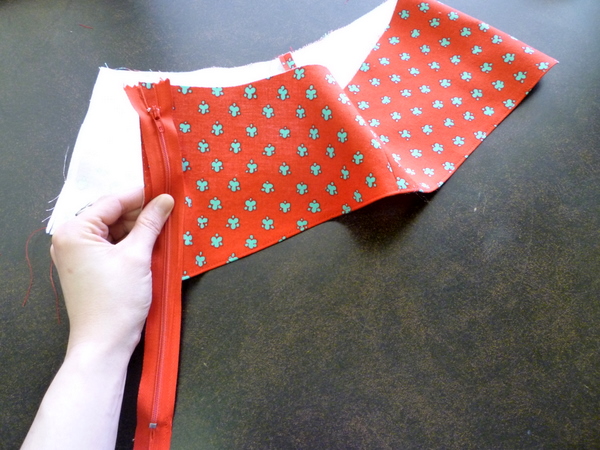 Some key points:
Some key points:
- Zipper is facing upwards. You can see the puller at the top, and the stopper at the bottom.
- Facing is also right-side-up. The right side of the fabric is showing.
- Zipper is lined up with the left side of the zipper next to the raw edge. The rest of the zipper falls to the right of the opening, with nothing extending past centre back.
Does yours look like this? Let’s pin it in place!
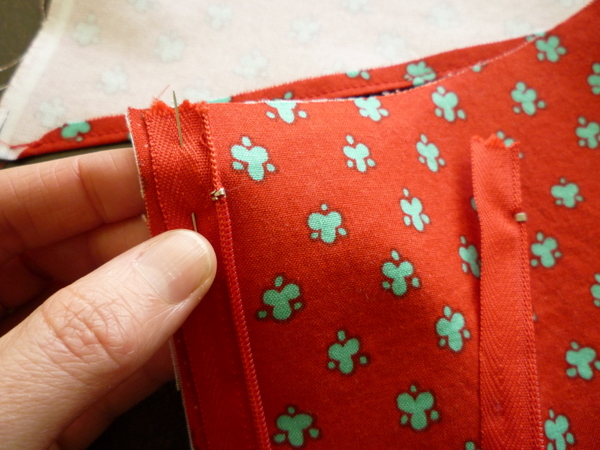 One thing that is really clear from the photo above is that the zipper teeth are lined up with the seamline. When we stitch the zipper into place, we’re sewing along our standard 5/8″ (1.5cm) seamline. There’s a teeny bit of extra space between the zipper edge and the raw edge.
One thing that is really clear from the photo above is that the zipper teeth are lined up with the seamline. When we stitch the zipper into place, we’re sewing along our standard 5/8″ (1.5cm) seamline. There’s a teeny bit of extra space between the zipper edge and the raw edge.
Make sense? Pin all the way down the zipper tape.
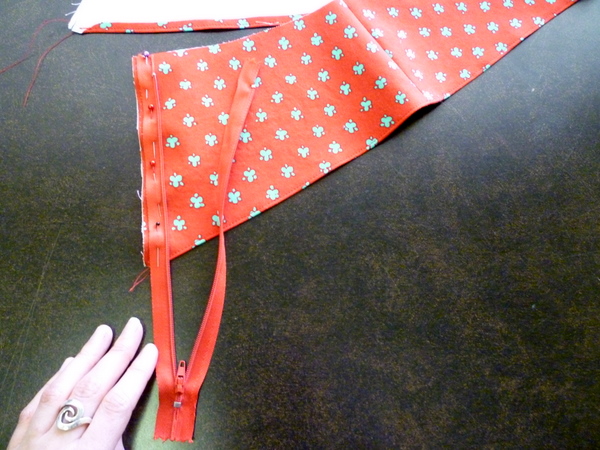 If you have lining: this is where your project will look a little different! Simply continue pinning the zipper tape to the lining, after the facing ends. My zipper is dangling past the edge of the facing, yours will be pinned to the lining.
If you have lining: this is where your project will look a little different! Simply continue pinning the zipper tape to the lining, after the facing ends. My zipper is dangling past the edge of the facing, yours will be pinned to the lining.
Switch your sewing machine foot to a zipper foot. Sew closely to the zipper teeth using the zipper foot.
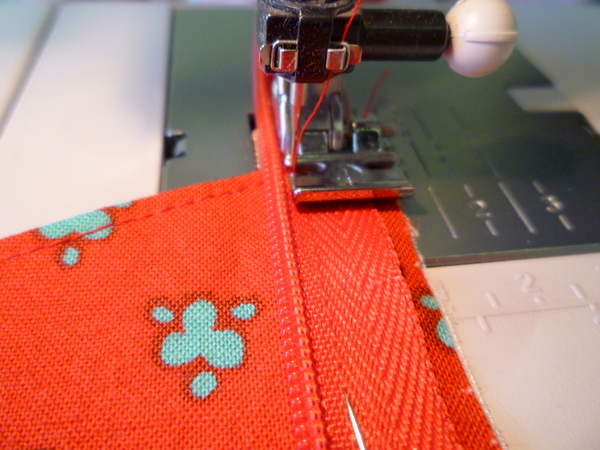 Don’t sew over the zipper teeth! If you do, carefully unpick your stitching and check that the teeth aren’t damaged and the zipper still works.
Don’t sew over the zipper teeth! If you do, carefully unpick your stitching and check that the teeth aren’t damaged and the zipper still works.
After we’ve sewn the zipper to one side of the facing, let’s sew it to the other side!
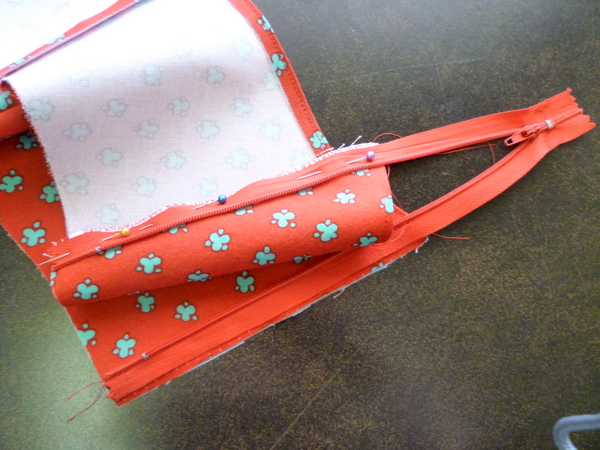
I’d suggest arranging your facing to look like the photo above, making sure the facing hasn’t twisted in the process. If this confuses you, read through to the end of the post so you can see the finished section!
Here’s what it will look like, when both sides have been stitched:
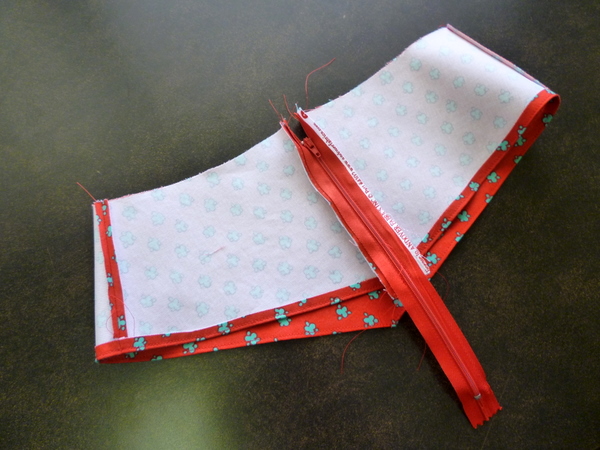 Here’s what it looks like from the other side:
Here’s what it looks like from the other side:
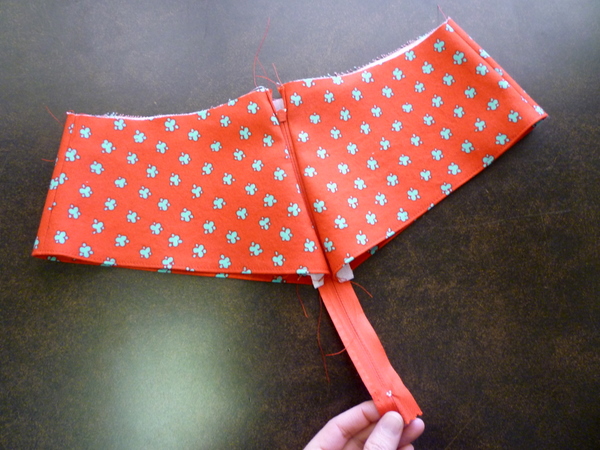 The first photo is from the outside of the skirt, the second photo is from the inside.
The first photo is from the outside of the skirt, the second photo is from the inside.
Press the facing lightly from the right side, being careful not to melt the zipper teeth. Use a press cloth or lightly steam the section and press with your fingers.
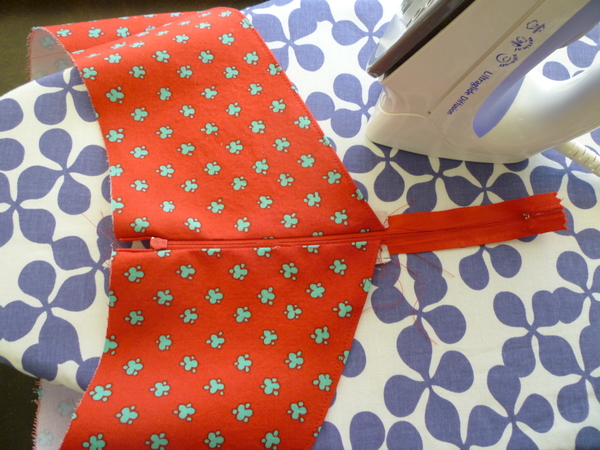 Does it make sense, what we did here? We’re basically sewing in reverse. Instead of slipstitching the facing to the zipper teeth at the end, we’re starting with that step, and then sewing the whole unit to the zipper.
Does it make sense, what we did here? We’re basically sewing in reverse. Instead of slipstitching the facing to the zipper teeth at the end, we’re starting with that step, and then sewing the whole unit to the zipper.
Any questions? Leave a comment below!

Oh I can see it now! I was a little bit confused but I see how simple this is.
I’m not doing the sew-along (but the crescent skirt is on my wish list) but I want to say that your tutorials are very clear, detailed and very useful even for other projects. So thank you very much !
This is wonderful! I can’t wait until the next post. I struggle with the placement of the end of the zipper and my skirt look a little funny at the top so I am really looking forward to the rest. Have you ever consider doing videos? Just wondering. thanks!
Even though I’m not participating in this sew-along, I find your posts so helpful! I have plans for my first zippered skirt and have been wondering how this is done. Thanks so much!
Hi Tasia,
Yay! We’re finally to the steps that I had trouble with on skirt #1! Since I’m doing the lining, I’ve added pics to my blog on how this step will look if you are lining your skirt. I’ll add the pics to the flickr group as well.
I’m not doing the sew along but I’m pretty excited about the rest of this tutorial. I hate zippers and, unfortunately, I can’t get a zipper foot for my machine because the stupid company changed how they attach their feet and whoever had the machine before me didn’t save any of the “fancy” feet that came with it. :(
This is a great idea. Will it work with a smaller facing as well? For example, at the back of a neckline?
I also want to thank you for your tutorial on attaching a bias edge to a neckline in the blouse sewalong. I wasn’t participating, but I followed your instructions on a different blouse I made and it worked perfectly.
wow – thank you for such a helpful post !
cardiganpumpkin.blogspot.com
@Stephanie:
Have you looked into getting a generic zipper foot for your machine? Hrm, I wonder how hard that would be to find one. I know there are generic invisible zipper feet but you’ll need the regular one too….
I’ve seen a technique like this on the internet for how to insert a zipper in a RTW way….I love these RTW tricks! Thanks for showing this to us. Looking forward to rest of tutorial.
This could just be total genius!! I’ve finished my first attempt at this pattern already (couldn’t wait!) so will have to try this zip method on my next. I loved this pattern. Just so you know. Blogged here:
http://portialawrie.blogspot.com/2011/05/sewaholic-crescent-skirt-too-good-to.html
Thankyou so much for such brilliant tutorials and neat techniques.
Px
Silly question: can this zipper method be used for invisible zippers, too?
I’m glad you said sewing the zipper to the skirt and then slip stitching the facing to the zipper is an acceptable method because when I saw your instructions I decided I must have been doing it wrong all these years! Although I do really like your method and I will use your method again now I’ve removed the zipper to take in the yoke :)
Hey everyone! Glad the tutorials are helpful and clear so far!
@Janine: You can use this method for invisible zippers, with a few differences. I know I’ve seen a good tutorial somewhere else, let me find it for you..
http://buzzybeesworld.blogspot.com/2010/04/tricks-of-trade-facing-invisible-zip.html
It’s actually easier for an invisible zipper!
@Jane Elise: Of course! You can use the usual method if you prefer, I thought I would include this alternate method in the instructions for something new. Whatever you’re most comfortable with! You can almost always sub your favourite techniques in on most patterns unless there’s some reason why it has to be done one way only.. but most cases it’s up to you!
@portia: Yay! I’m so glad you loved the pattern. Isn’t it the most comfortable skirt?
@Caroline C.: You’re welcome! It is a more RTW approach to zippers, they avoid hand-sewing in manufacturing because it’s expensive – so there are always tricks we can apply to our own sewing projects!
@Harriet: Yes, it will work on a smaller facing too! This concept applies to any facing and zipper application.
@Stephanie: Oh no! I don’t know what to suggest, other than looking online for people selling machine feet, or checking with your local sewing machine shop. (Or looking for a new machine eventually…) Perhaps there are generic feet you can get but I haven’t done much research.
@Ellen: Fantastic! Thanks so much, it’s so helpful to have real-life photos for the lining steps!
@gina: I have considered doing videos! I need to look into editing tools and ways to add text and whatnot.. otherwise it will be a rather dull video! One of the things I want to try this year is video tutorials.. soon!
Hi Tasia,
Would this method work to put a zip in a lined dress? I’ve never really known how to finish the lining part of the dress when putting a zip in and had the random thought last night that this might work…
I was initially planning on hand-picking the zip but i don’t think i’ll have the time now, and i don’t know how finish the lining when hand picking.
@Rachel: I think this would work when sewing a zip in a lined dress! You could also check out this tutorial here for how to do it on an invisible zip.
http://buzzybeesworld.blogspot.com/2010/04/tricks-of-trade-facing-invisible-zip.html
She adds the facing after sewing the zipper in, which is a more natural sequence of events, and might be easier to do on a lined dress.
Depending on how the lining is sewn into the dress, sometimes it’s easier to treat the two layers (lining and fabric) as one, and finish the edges together, then sew the zipper in.
Another thing you could do, if you’re going to hand-pick the zipper, is sew the lining to the fabric right-sides-together, and then turn it right side out, so the lining finishes the opening. Then, hand-pick the zipper into the clean-finished opening.
This dress was constructed like that, in the instructions:
http://sewaholic.net/groovy-sixties-shift-dress-mccalls-7743/
So you have this finished bodice centre back opening, finished with a lining seam, to sew the zipper into. It worked really well although it ONLY lets you put in a regular zipper that way.
I hope this helps!
Hi Tasia. I have a couple of zipper questions if that’s ok. Does the gap between the end of the zipper teeth and the top edge of the waistband need to be 1.5 cm or a couple of mm bigger? My zip has quite a big area at the top so I need to know how much gap I should leave. Also, is the actual stitching line for the zipper 1.5 cm from the edge. The actual zipper teeth extend a couple of mm beyond the stitching line and I’m wondering if that is included in the 1.5 cm, making the stitching line around 1.3cm? Also I notice from your picture that you seem to be sewing 1 cm from the edge? I hope this makes sense! Many thanks.
@Sewingdina: Hi! Of course you can ask zipper questions! The gap between the zipper teeth and the top edge is about 1.5cm. We’ll be sewing a 1.5cm seam across the edge of the zipper, so if you have the teeth start at that point, or a teeny bit below, that will work!
The actual stitching line for the zipper is 1.5cm from the edge – mine looks like less because I’ve moved the needle position to the left, for using the zipper foot.
Does that help? I hope so! :)
Hi Tasia. Thanks for your help. I guessed right!
Well, this is certainly an interesting way to install a zipper. I might use this on my future projects.
I’ve just discovered your website, yay! Your workmanship is wonderful! I’m reminded of learning to sew from my grandmother who emigrated from Nova Scotia to Portland, Oregon. I wish I’d paid more attention and kept using what she’d taught me, but I recognize the techniques in your work. She actually did men’s tailoring to earn money for the family’s trip across Canada in the 1920s. It was a start-and-stop train trip: My mother was born in Regina in 1921. I think they crossed at Blaine, WA, when she was 3 years old. Thanks for reviving my memories!
Hi! I’m a new follower and found this page as a result of searching for a way to insert a zip into a dress with a skirt lining. I don’t plan to line the bodice of the dress.
Your instructions are so clear – great pictures, great step-by-step.
My question: Does using this method leave enough fabric to topstitch the zipper? I would topstitch it by machine.
My usual method (in an unlined dress and which doesn’t work all that great for me) is to sew the seam shut and then pin the zip in, then sew (and rip out and repeat!). Then give up and just topstitch it the best I can. Then rip out the basting stitch that sewed the seam shut. (It’s confusing me now, but I think that’s what I do! :))
Thanks so much!
I just used these EXCELLENT instructions to apply a facing with zipper to a modified blouse front. I like front zippered blouses/shirts and changed a pattern from a button front to the zipper. I previously had done this, but the zipper/facing application was not a pleasant experience doing it the conventional way. This technique worked marvelous. Thank you so much for clear photo representation of the steps to take.